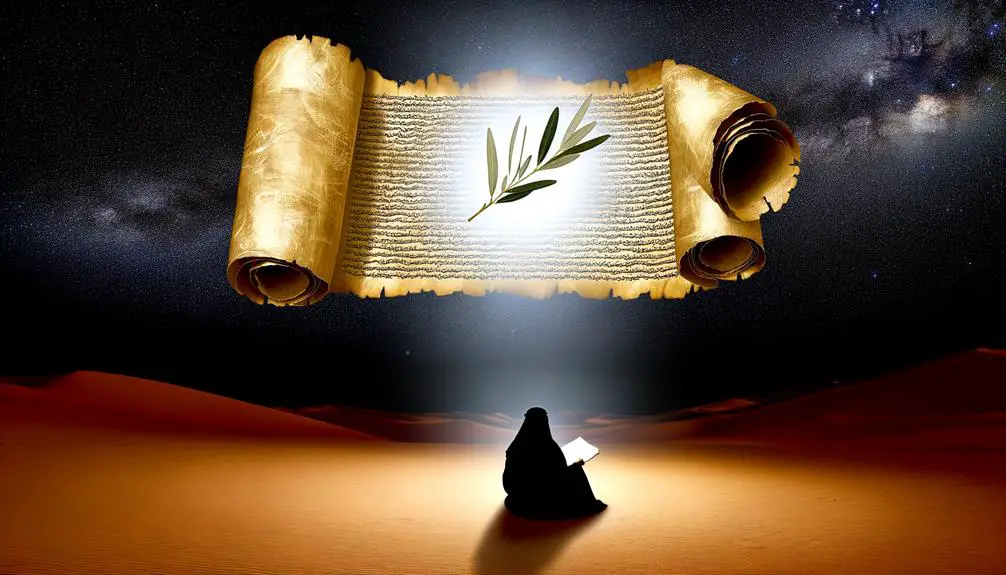This exploration of 'shew' in the Bible unveils hidden layers of divine revelation and human interaction, inviting a deeper dive into spiritual mysteries.

What Does Shew Mean in the Bible
Just as Moses lifted up the serpent in the wilderness, the term 'shew' in the Bible lifts the veil on divine revelations and human responses to God's will.
You might find yourself intrigued by the way 'shew' bridges ancient texts with contemporary understanding. This word carries layers of meaning, from straightforward demonstrations of God's power to complex symbolic messages meant to guide and instruct.
By exploring 'shew' in both Old and New Testament contexts, you'll unlock insights into how divine messages were not only revealed but also received and interpreted by those who walked the paths of faith before us.
What might these ancient demonstrations of faith reveal about your own spiritual journey?
Key Takeaways
- 'Shew' in the Bible reflects God's desire to reveal His will, demonstrate His power, and confirm His promises.
- It originates from Old English 'scēawian,' highlighting the historical and linguistic context of biblical interpretation.
- In the New Testament, 'shew' signifies divine revelations and the early Christians' experiences of the divine.
- The term encapsulates actions of faith, prophetic messages, and miracles as demonstrations of divine intervention and human trust.
Origins of 'Shew

The term 'shew' in the Bible originates from the Old English word 'scēawian,' meaning to look at or inspect, reflecting its usage in biblical texts to denote the act of revealing or demonstrating something divine or significant. This linguistic root provides insight into the cultural and religious contexts in which the word was employed, emphasizing the act of divine revelation or the presentation of something to be observed and understood by the faithful. The evolution of the term 'shew' into its current form and meaning is a testament to the dynamic nature of language, particularly in the context of religious texts that have been translated and retranslated over centuries.
Linguistic evolution plays a crucial role in understanding how biblical terms, such as 'shew,' have shifted in meaning and interpretation through time. This process isn't only indicative of changes in language but also reflects shifts in cultural and theological understanding. As the English language evolved, so did the meanings and connotations of words used in religious texts, leading to potential translation discrepancies. Such discrepancies arise from the challenge of conveying the original Hebrew and Greek texts' nuanced meanings into English—a language with its own evolving vocabulary and semantic ranges.
These translation discrepancies highlight the complexity of biblical interpretation and the importance of considering historical linguistic contexts. They underscore the need for scholars to approach biblical texts with an awareness of the linguistic evolution that influences our understanding of key terms. Analyzing the origins and development of words like 'shew' provides valuable insights into the interpretative challenges and considerations necessary for a nuanced understanding of biblical texts.
Shew' in Old Testament Contexts

Understanding the term 'shew' within the Old Testament contexts reveals its pivotal role in conveying divine actions and intentions to humanity. The usage of 'shew' in these ancient texts isn't merely about displaying or presenting something visibly; it's intricately tied with the notion of revelation and divine communication. Language evolution and cultural interpretations have significantly influenced how we understand these occurrences today.
- Revelation of Divine Will: In the Old Testament, 'shew' often signifies God's intent to reveal His will or plan to His people. This isn't just about visual demonstration but encompasses a broader, more profound revelation of divine purposes.
- Manifestation of God's Power: 'Shew' also denotes the demonstration of God's power and glory. Through miraculous signs and wonders, God 'showed' His supremacy and authority, reinforcing His relationship with humanity.
- Guidance and Direction: The term is used when God 'shows' the path or direction to His followers. It's about illuminating the way forward, providing clarity and assurance amidst uncertainty.
- Covenant and Promises: 'Shew' encapsulates the confirmation of God's promises and covenants. Through various signs, God 'showed' His faithfulness and commitment to His agreements with humanity.
These insights into 'shew' within the Old Testament not only highlight the richness of biblical language but also underscore the complex interplay between divine revelation and human understanding. Language evolution and cultural interpretations play crucial roles in shaping our comprehension of these ancient texts, allowing us to appreciate the multi-faceted ways in which the divine communicates with humanity.
Shew' in New Testament Insights

Exploring 'shew' within the New Testament offers insight into how early Christians experienced and interpreted divine revelations. The term's usage in these texts is pivotal, shedding light on the evolving nature of language and its impact on religious understanding. As you delve deeper, you'll find that 'shew' in the New Testament isn't merely a translation artifact but a reflection of the cultural and theological shifts occurring within early Christian communities.
The linguistic evolution from the Old to the New Testament highlights how 'shew' adapted to the changing contexts of its use. This evolution isn't just about the word itself but signals a broader transition in how divine messages were communicated and understood. The New Testament, written primarily in Koine Greek, showcases this shift, with 'shew' often translating to terms that emphasize revelation and manifestation. This difference in language use reflects not just a shift in vocabulary but in the very nature of divine-human interaction as portrayed in these texts.
Moreover, the cultural interpretations of 'shew' within the New Testament illuminate the diverse ways early Christians perceived their relationship with the divine. The term becomes a lens through which to view the multifaceted nature of revelation, encompassing visions, teachings, and even the person of Jesus Christ himself as the ultimate 'shewing' of God's will.
Understanding 'shew' in the New Testament, therefore, requires a nuanced appreciation of both its linguistic nuances and its broader cultural and theological implications. It's a term that captures the dynamic interplay between divine revelation and human interpretation, offering a window into the spiritual landscape of early Christianity.
Symbolism and Significance

Delving into the symbolism and significance of 'shew' in biblical texts reveals a complex interplay between divine revelation and human perception, underscoring its pivotal role in shaping early Christian theology. This term, dense with meaning, operates within a spectrum of cultural interpretations and historical contexts, offering a multifaceted lens through which to explore the sacred narratives.
To convey a deeper understanding, consider the following aspects:
- Historical Contexts: 'Shew' isn't merely a word but a window into the era it was used. It reflects the linguistic preferences and theological inclinations of its time, providing insight into how early Christians perceived divine manifestations.
- Cultural Interpretations: The interpretation of 'shew' varies significantly across different cultures and epochs. This variability underscores the importance of considering the cultural backdrop against which biblical texts were written and later read.
- Theological Implications: The use of 'shew' in scripture often hints at the unveiling of divine truths. It serves as a marker for moments of revelation, where the divine intersects with the earthly, challenging and expanding contemporary understandings of God's nature and will.
- Literary Significance: Beyond its theological implications, 'shew' also carries literary weight, contributing to the narrative and poetic dimensions of biblical texts. Its usage enriches the storytelling, adding layers of meaning that invite deeper reflection and interpretation.
Through these lenses, the term 'shew' emerges as a crucial element in the tapestry of biblical literature, inviting readers to engage with the text at both intellectual and spiritual levels.
Divine Revelations Unveiled

Building on the multifaceted role of 'shew' within biblical narratives, this section examines how divine revelations are intricately unveiled through its usage, offering profound insights into the divine-human interaction. As you delve deeper into the text, you'll find that 'shew' isn't merely a passive display but a dynamic medium through which the complexity of divine messages is communicated. This becomes particularly evident in accounts of mystical experiences and spiritual awakenings, where the term transcends its conventional boundaries to embody a more profound, revelatory essence.
These narratives often depict moments where individuals are granted access to divine wisdom or visions, beyond the ordinary, through a 'shewing'. It's in these moments that 'shew' aligns with the unveiling of truths that were previously obscured or beyond human comprehension. This interaction isn't just about the transmission of information; it's about transformation. The individuals involved emerge from these experiences fundamentally changed, having been 'shewn' a reality that redefines their understanding of themselves and their place within the divine schema.
What's captivating about this process is how it underscores the active engagement of the divine in human affairs. Through 'shew', the Bible illustrates not a distant deity but a present, communicative force intent on guiding humanity towards enlightenment and truth. The instances of 'shew' thus serve as pivotal junctures in the biblical narrative, marking points of spiritual awakening and the unfolding of divine plans.
In analyzing these moments, it becomes clear that 'shew' is more than a literary device; it's a conduit for divine revelations, offering a glimpse into the sacred interplay between the celestial and the terrestrial.
Demonstrations of Faith

You'll find that the Bible frequently portrays demonstrations of faith through various visible signs and miracles. These manifestations not only showcase the believers' trust in divine power but also emphasize the significance of actions in expressing faith.
This discussion will analyze how biblical narratives use miracles and actions as a lens to understand and interpret faith's tangible expressions.
Faith's Visible Signs
Throughout biblical narratives, visible demonstrations of faith serve as pivotal moments where individuals' belief systems manifest tangibly in their actions and decisions. These manifestations aren't merely personal but extend into the realm of spiritual practices and provide moral evidence of their faith to those around them.
- Charitable Acts: Demonstrating love and compassion through helping those in need, reflecting Jesus' teachings on servitude.
- Prayer and Worship: Engaging in these practices publicly signals a deep trust in and reliance on a higher power.
- Moral Integrity: Making choices that align with biblical principles, even when faced with adversity, showcases a commitment to faith.
- Evangelism: Sharing one's faith with others, not merely through words but through a life that exemplifies the teachings of the Bible.
These actions reveal the depth and authenticity of one's faith to the world.
Biblical Miracles Showcased
In the context of biblical narratives, miracles serve as profound demonstrations of faith, often marking pivotal moments where divine intervention intersects with human belief. These divine interventions, witnessed through the parting of the Red Sea or Jesus healing the sick, aren't just supernatural events; they're carefully documented instances that challenge and deepen our understanding of faith.
Miracle interpretations vary widely, but at their core, they highlight the power of belief and the direct involvement of a higher power in the affairs of humanity. These narratives don't merely recount extraordinary events; they invite a reflective inquiry into the nature of faith itself, urging believers to see beyond the surface and recognize the profound implications of divine intervention in their lives.
Trust Through Actions
Demonstrations of faith, often embodied through trust in actions, serve as pivotal markers of belief, deeply intertwining human experience with divine expectation. This interplay between actionable belief and demonstrative loyalty highlights a profound truth within the biblical narrative:
- Actionable belief isn't merely an internal conviction but manifests in deeds that reflect trust in divine promises.
- Demonstrative loyalty to divine principles showcases a believer's commitment beyond words, embodying faith through tangible actions.
- Trust in actions goes beyond mere compliance; it's an expression of deep faithfulness and reliance on divine guidance.
- Such trust signifies a believer's willingness to be led by a power greater than oneself, reinforcing the bond between the divine and the human through lived experiences.
Shew' and Prophetic Messages

Analyzing biblical texts reveals that 'shew' often serves as a vehicle for conveying prophetic messages, emphasizing its integral role in divine communication. The term not only bridges the divine with the human but also encapsulates the essence of prophetic accuracy and interpretive challenges. Prophets were tasked with delivering messages that were often symbolic or cryptic, necessitating a keen understanding and interpretation.
The act of 'shewing' in the prophetic context underscores a dynamic interaction between revelation and comprehension. This dynamic is pivotal, as it determines the efficacy of the prophecy's transmission and its subsequent impact. However, the interpretive challenges that arise cannot be understated. The inherent ambiguity in some messages leads to varied interpretations, which, in turn, can affect the perceived prophetic accuracy.
To illustrate the complexity and significance of 'shew' in prophetic messages, consider the following table:
Aspect of 'Shew' |
Significance in Prophetic Messages |
|---|---|
Transmission |
Acts as a conduit for divine revelations |
Symbolism |
Encodes messages in symbolic language |
Interpretation |
Requires discernment to understand true meanings |
Impact |
Influences the reception and actions of the audience |
Accuracy |
Challenges in interpretation can affect perceived accuracy |
This table underscores the multifaceted role of 'shew' in the context of biblical prophecy. It's not merely about the act of showing but involves a complex process of communication, understanding, and reaction. As you delve deeper into the biblical texts, the intricate relationship between 'shew' and prophetic messages becomes evident, highlighting the profound impact of divine communication on human history.
Frequently Asked Questions
How Has the Translation of the Word 'Shew' Into Modern Versions of the Bible Impacted Its Interpretation Among Contemporary Scholars and Theologians?
The translation of 'shew' into modern Bible versions, influenced by advances in modern linguistics and translation technology, has significantly impacted its interpretation among today's scholars and theologians.
You're seeing a deeper understanding and more nuanced discussions around biblical texts. This evolution ensures that interpretations are more aligned with the original meanings, fostering a richer theological discourse and enhancing the accuracy of biblical teachings for contemporary audiences.
Are There Any Notable Discrepancies Between the Use of 'Shew' in Ancient Manuscripts and Its Rendering in the King James Version of the Bible?
You'll find that manuscript variations and translation challenges have indeed led to notable discrepancies between the ancient texts and the King James Version's use of 'shew.'
Scholars face the task of deciphering these differences to understand the original meaning accurately. The process is complex, considering the evolutionary nature of language and the intricacies of ancient scripts.
These discrepancies underscore the importance of careful, scholarly analysis in translating biblical texts.
How Do Non-Abrahamic Religions or Cultures Interpret the Concept of 'Shew' as It Is Presented in Biblical Texts?
Imagine unraveling a tapestry of ancient stories, each thread representing a different belief system. In this context, you'd find that cultural interpretations of concepts similar to 'shew' vary widely across non-Abrahamic religions or cultures.
When exploring comparative mythology, it's clear that while the essence remains, the nuances differ. Analytically speaking, these variations reflect the diversity in human spirituality and understanding, showcasing how universally shared concepts are adapted to fit unique cultural frameworks and narratives.
In What Ways Has the Understanding of 'Shew' Influenced Christian Liturgical Practices or Religious Rituals Over the Centuries?
In exploring how 'shew' has influenced Christian liturgical practices, you'll find its impact profound in ritualistic symbolism and liturgical garments.
This term's interpretation has evolved, deeply embedding itself in ceremonies, influencing the design and use of sacred attire, and shaping the visual and symbolic aspects of worship.
Analyzing these elements offers a scholarly insight into Christianity's ritualistic evolution, revealing how ancient concepts continue to define and enrich modern religious expressions.
Can the Concept of 'Shew' Found in the Bible Be Correlated With Similar Themes in Other Ancient Texts Outside of the Biblical Canon?
You'll find that the concept of 'shew' in the Bible resonates with themes in other ancient texts through comparative mythology and intertextual analysis. This approach reveals shared narratives and symbols across cultures, suggesting a common human experience or understanding.
Conclusion
You might argue that exploring the term 'shew' feels archaic, perhaps even irrelevant in today's fast-paced world. However, delving into its biblical contexts reveals its profound impact on understanding divine messages and the essence of faith.
'Shew' isn't just an outdated word; it's a bridge to deeper spiritual insights, connecting us with the timeless wisdom of divine revelation and prophetic visions. This exploration enriches our comprehension of faith's demonstrations, making ancient texts vibrantly relevant to our modern spiritual journey.



Sign up